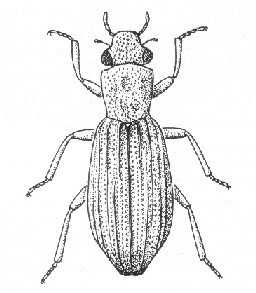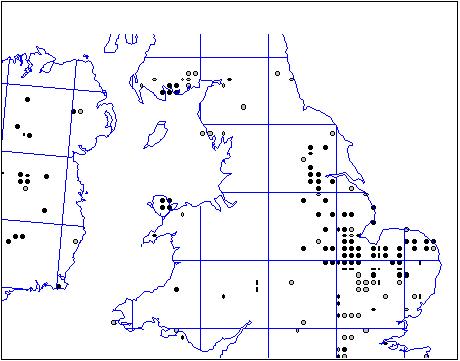
Hydrochus elongates
By Garth Foster
There are currently 1,207 records of 166 species of water beetle in Worcestershire, a significant improvement on when I reported in Worcestershire Record 9 November 2000.
Harry Green invited me to give a talk at the WBRC Annual Meeting at Crowle on 13th April 2002, and I was able to spend the rest of that weekend searching for new sites, and, as it turns out, three species apparently new for the county. A group of us visited several ponds at Grimley on Sunday 14th April, and it took a botanist, John Day, to find the first specimen of the most interesting species, Hydrochus elongatus. I might also admit that I had worked the same pond in the same place the previous day without success - talk about beginner's luck! This beetle, which is about 4 mm long, sluggish, black and stick-shaped, is easily overlooked - and is frequently found on the sorting tray after everything else has been thrown back into the pond. This beetle, which is associated with ponds with emergent vegetation, appears to be wholly new for Worcestershire, was found in two more of the ponds at Grimley, again with John taking a leading role.

Hydrochus elongates
Another interesting species was the 2mm long diving beetle, Graptodytes granularis, which is black with yellow stripes just visible to the unaided eye. This beetle was in a reedmace marsh in a pond at Grimley. The only earlier records for Worcestershire are from Moorcroft (I know the ceramics but I don't know the place -any offers? (See below - Ed) by J.E. Fletcher in the 19th Century, and by the late Don Goddard at Mosely in April 1982. Worcestershire is in the thin skein of sites between this species' stronghold around the Wash to outposts scattered around Wales and Ireland.
Grimley also yielded a single specimen of Haliplus flavicollis, again new for the county. It is supposed to live on stoneworts as a larva, switching to the eggs of plume midges (the bloodworm-type midges of muddy pools) as an adult. The minute Hydraena rufipes was found in the Leigh Brook at Leigh. I pointed out in my talk that the running water Hydraena species are nearly all endangered, with much evidence of decline, presumably because they are hypersensitive to pollution. I know of only two earlier records of rufipes in Worcestershire, but it can be abundant in the upper reaches of the Teme in Herefordshire. I was shocked to find that Hydroporus incognitus, of which one specimen was seen at Grimley, had not been recorded from the county before; certainly the habitat, shaded pools, is not often worked as it rarely looks inviting.
The drawing of Hydrochus elongatus is one prepared by Mrs Rosemary Wise. The map shows much of the distribution of Graptodytes granularis across Britain and Ireland, black symbols being from 1980 onwards.
Graptodytes granularis distribution map

- Harry Green
John Edward Fletcher 1836-1902 lived and worked in Worcester all his life and was, according to his Obituary, ..... a man of rare intelligence ..... of considerable education, probably largely self-taught. Reserved and retiring in the extreme, he did not mix with others of similar tastes, even in his own locality, and his doings and acquirements were more known to the wider circle of British entomologists at large rather than at home. His entomological studies started when he was age 15 and continued almost until his death. He wrote many short notes to Entomologist's Monthly Magazine and virtually the whole section on Insecta in the Worcestershire Victoria County History. His insect collection was sold to the Worcester Museum after his death. Apparently in Lepidoptera and Coleoptera were integrated with other collections and looked after, but Geoff Trevis and I discovered masses of old cigar boxes in the bowels of the museum containing specimens of all Orders, which are almost certainly his collection, ravaged by museum beetle and thickly coated with industrial grime. The meticulous labelling shows that he worked around Worcester St Johns and out into the countryside beyond for about ten miles.
In the context of Garth Foster's comment, Don Goddard found Graptodytes granularis at Mosely which is about 1 km S of the centre of Monkwood (SO810595) while Moorcroft Farm (SO811605) is about 1 km N of Moseley, between Monkwood and Sinton Green village on the modern 1:25000 map. This is surely the Fletcher site?
Obituary John Edward Fletcher1902 Entomologist's Monthly Magazine 38:134-135.
| WBRC Home | Worcs Record Listing by Issue | Worcs Record Listing by Subject |